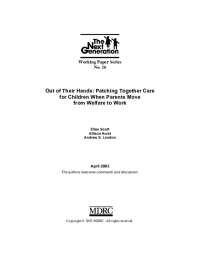Out of Their Hands
Patching Together Care for Children When Parents Move from Welfare to Work
Summary of Key Findings for Working Paper No. 16
Background
Between 1994 and 2000, the welfare rolls declined by 57 percent and employment among low-income single mothers increased by some 10 percentage points, from approximately 68 percent to almost 78 percent. While these dramatic changes cannot be attributed entirely to changes in the welfare system, a central goal of welfare reform was to move welfare recipients into the labor force. By implication, these policy changes require single parents to find alternative sources of child care to replace their own uncompensated care when they take jobs outside the home. Using data from in-depth longitudinal interviews with 38 welfare-reliant mothers residing in the most disadvantaged neighborhoods in Cleveland, this paper examines how women responded to the work mandates of welfare reform and provided alternative care for their children once they moved into the paid labor force.
Key Findings
- In these low-income households, parents expend enormous amounts of time and energy patching together child care arrangements that include complex combinations of formal and informal care. Child care solutions were found to be contingent on the age of child to some extent, but they are contingent to a much greater extent on the resources available to the family.
- Most families drew upon many different resources each day to meet the needs of children of different ages, cover the long hours parents were away from home working multiple jobs or traveling between work and home, or accommodate the mothers’ erratic schedules and second- and third-shift jobs common to low-wage employment.
- Parents commonly patched together alternate care arrangements over time as they adjusted to changes in employment or encountered problems with an existing child care arrangement.
Conclusions and Implications
The characteristics of low-wage employment create pressures for flexibility in child care arrangements, yet the most flexible arrangements are often less reliable and of lower quality than more formal, center-based care. Thus, flexibility and quality were often tradeoffs for the women interviewed for this paper. Sometimes the multiple arrangements that families patched together met their need for reliable, flexible and stable child care and represented a preferred and creative use of existing resources. At other times, the patchwork was unreliable, unstable, and sometimes even dangerous. These arrangements represented a choice of last resort for women with few resources to draw upon who faced work requirements and time limits on the receipt of welfare benefits.






